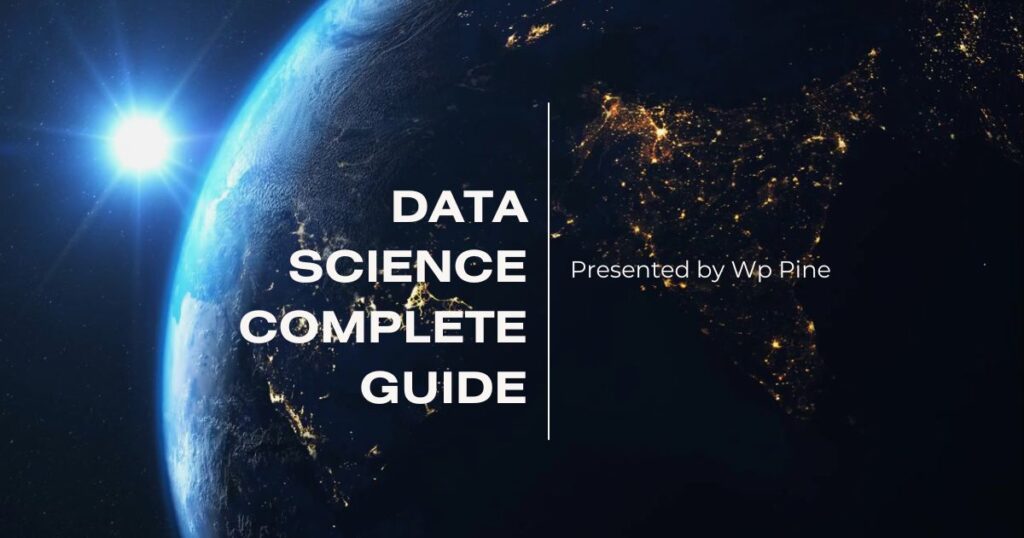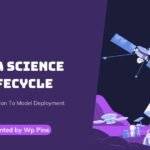Data science is a multidisciplinary field that leverages scientific methods, algorithms, processes, and systems to extract meaningful insights and knowledge from both structured and unstructured data. It serves as a bridge between raw data and actionable insights by combining key elements from statistics, computer science, and domain expertise. The primary goal of data science is to enable data-driven decision-making by analyzing patterns, building predictive models, and uncovering trends within complex datasets. For beginners, grasping foundational concepts such as data manipulation, statistical analysis, and machine learning, along with mastering essential tools like Python, R, and SQL, is critical for successfully navigating and contributing to this ever-evolving field.
What is Data Science?
Data science involves a set of techniques and principles for analyzing large amounts of data. It encompasses the entire data lifecycle, from data collection and processing to analysis and visualization. The goal is to uncover patterns, derive insights, and make predictions based on data.
Key Components of Data Science
- Data Collection: Gathering raw data from various sources, such as databases, web scraping, sensors, and surveys.
- Data Processing: Cleaning and transforming raw data into a usable format. This step includes handling missing values, removing duplicates, and normalizing data.
- Data Analysis: Applying statistical methods and algorithms to analyze data and identify trends, patterns, and correlations.
- Data Visualization: Presenting data in graphical formats to communicate findings effectively.
- Machine Learning: Using algorithms to build models that can predict outcomes or classify data.
- Data Interpretation: Drawing meaningful conclusions and insights from the analysis and visualization.
Essential Skills for Data Scientists
To become proficient in data science, one needs to develop a diverse skill set:
- Programming: Proficiency in languages such as Python and R is essential. These languages offer libraries and frameworks for data manipulation, analysis, and machine learning.
- Statistics: Understanding statistical methods and probability is crucial for analyzing data and building models.
- Data Manipulation: Skills in data wrangling and manipulation using tools like Pandas and SQL.
- Machine Learning: Knowledge of machine learning algorithms and frameworks like Scikit-Learn, TensorFlow, and Keras.
- Data Visualization: Ability to create informative visualizations using tools like Matplotlib, Seaborn, and Tableau.
- Domain Knowledge: Comprehending the exact sector or domain of business in which data science is used to make better decisions.
Data Science Process
The data science process involves several iterative steps to ensure robust analysis and accurate insights:
- Define the Problem: First of all, one must be fully aware of the business problem or research question that is to be addressed and solved using data analysis.
- Collect Data: Gather relevant data from various sources. Cleansing and preprocessing of data will help in quality of data that will be used in the analysis.
- Explore Data: Perform exploratory data analysis (EDA) to understand data distributions, identify patterns, and detect anomalies.
- Model Building: Select and train appropriate machine learning models based on the problem type (classification, regression, clustering).
- Evaluate Models: Assess model performance using metrics like accuracy, precision, recall, and F1 score. Perform cross-validation to ensure model robustness.
- Deploy Models: Integrate models into production systems to make real-time predictions or decisions.
- Monitor and Maintain: Continuously monitor model performance and update models as new data becomes available.
Tools and Technologies in Data Science
Data scientists use various tools and technologies to handle different aspects of the data science process:
Programming Languages
- Python: Widely used for its simplicity and extensive libraries like NumPy, Pandas, Matplotlib, and Scikit-Learn.
- R: Popular in academia and research for statistical analysis and visualization.
Data Manipulation and Analysis
- Pandas: An open-source data analysis software environment written in Python with data structures such as DataFrames.
- NumPy: A library for numerical computing with support for large multi-dimensional arrays and matrices.
Machine Learning
- Scikit-Learn: A Python library offering simple and efficient tools for data mining and data analysis.
- TensorFlow and Keras: Software libraries applied while constructing as well as training deep learning models.
Data Visualization
- Matplotlib and Seaborn: Python packages that one can use when developing static, animated and interactive graphics.
- Tableau: A powerful data visualization tool used for creating interactive and shareable dashboards.
Big Data Technologies
- Apache Spark: An open-source distributed computing system for big data processing and analytics.
- Hadoop: A system that enables distributed storage and large data processing with the help of the MapReduce model.
Real-World Applications of Data Science
Data science has a wide range of applications across various industries:
Healthcare
- Predictive Analytics: Make accurate predictions concerning patients’ prognosis, the likelihood of readmissions, and disease spread..
- Medical Imaging: Use machine learning to detect abnormalities in X-rays and MRI scans.
Finance
- Fraud Detection: Identify fraudulent transactions using anomaly detection techniques.
- Risk Management: Assess financial risks and predict market trends.
Marketing
- Customer Segmentation: Group customers based on purchasing behavior and demographics.
- Sentiment Analysis: Analyze customer feedback and social media posts to gauge sentiment.
Retail
- Inventory Management: Predict demand and optimize stock levels using sales data.
- Recommendation Systems: Provide personalized product recommendations based on customer preferences.
Transportation
- Route Optimization: Optimize delivery routes and reduce travel time using GPS data.
- Predictive Maintenance: Manage equipment status proactively to identify possible failure points and schedule maintenance work to avoid business disruptions.
Challenges in Data Science
Despite its potential, data science faces several challenges:
- Data Quality: Ensuring data accuracy, completeness, and consistency is crucial for reliable analysis.
- Data Privacy: Protecting sensitive information and complying with regulations like GDPR and CCPA.
- Model Interpretability: Understanding and explaining model predictions, especially in black-box models like deep learning.
- Scalability: Handling large datasets and computationally intensive tasks efficiently.
- Bias and Fairness: Ensuring models do not perpetuate or amplify biases present in the data.
Future Trends in Data Science
Data science is an evolving field with several emerging trends:
- Automated Machine Learning (AutoML): Tools and frameworks that automate the process of model selection, hyperparameter tuning, and deployment.
- Explainable AI (XAI): Techniques to make machine learning models more transparent and interpretable.
- Edge Computing: Processing data closer to the source (e.g., IoT devices) to reduce latency and improve efficiency.
- AI Ethics: Developing frameworks and guidelines to ensure the ethical use of AI and data science.
- Quantum Computing: Leveraging quantum computing for complex data analysis tasks that are currently infeasible with classical computing.
Detailed Examples of Applications
To further illustrate the power of data science, let’s delve deeper into some applications:
Healthcare
The area in which this might have the most positive impact on patient care and medical research is in healthcare itself. On the other hand, predictive analytics can be used to predict outbreaks of diseases by looking at vast amounts of epidemiological data. For instance, already during the pandemic, COVID-19 data scientists have played a central role in modeling the spread of the virus, predicting its consequences, and helping governments and health organizations respond to them.
Another very strong domain within data science is medical imaging. Machine learning algorithms could be used to run through medical images such as X-rays, MRIs, and CT scans to identify abnormalities with a very high degree of accuracy. For example, using eye scans, an AI model developed by DeepMind identified eye diseases with a high degree of accuracy—quite often surpassing human specialists.
Finance
In financial services, the case of fraud detection is linked to the identification of unusual patterns in transaction data. That mostly depends on the fight against financial crimes. In real-time, machine learning models flag potentially fraudulent activities with the analysis of historical transactions for instant action to prevent such frauds.
Another critical application is risk management. The financial institution applies data science in the estimation and prediction of risks associated with loans and investments. Looking at such factors as credit scores, transaction history, and economic indicators, data scientists model events like the probability of default, thus helping a bank make an informed decision while lending.
Marketing
With advanced customer segmentation and sentiment analysis, data science has transformed the nature of marketing. Customer segmentation could be based on categorizing the company’s customer base into distinct groups, performed on parameters related to purchasing behavior and demography. In this way, it allows companies to develop proper strategies for their various clientele segments and engage customers effectively.
On the other hand, sentiment analysis is a process for scanning customer reviews, social media posts, and other textual data to determine the sentiment of the public towards a product or brand. As an example, using techniques in NLP, data scientists can tell whether the customers are leaving positive, negative, or even neutral feedback, which makes up very useful knowledge for marketing strategies.
Retail
Inventory management and recommendation systems fall under the category of data science in the retail industry. Demand forecasting is required for planning and maintaining optimum stocks and keeping associated costs at a minimum. This requires data scientists to very accurately forecast demand, using historical sales data and seasonal trends, along with other factors that might be exogenous, such as weather conditions.
Recommendation systems, as in the case of Amazon and Netflix, are used to offer customers a more personalized selection of their products based on their past behavior and preference. They use collaborative and content-based filtering techniques to suggest products of interest to customers, hence increasing sales and customer satisfaction.
Transportation
The impact of data science on transportation is very evident. Route optimization algorithms compute optimum routes using traffic data, road conditions, and delivery schedules to chart out the most efficient routes for delivery vehicles. This not only reduces fuel consumption and associated operational costs but also improves delivery times.
Another critical application in transportation is predictive maintenance. With predictive modeling on sensor data for a vehicle or any equipment, data scientists can determine the likelihood of component failure and then schedule maintenance before breakdown. This proactive approach reduces downtime and maintenance costs, thereby improving operational efficiency.
Conclusion
Data science is a dynamic and interdisciplinary field that combines statistics, computer science, and domain knowledge to extract valuable insights from data. For beginners, understanding the fundamental concepts, tools, and processes is crucial for navigating
this complex landscape. By mastering skills in programming, statistics, data manipulation, and machine learning, aspiring data scientists can unlock the potential of data to drive innovation and make informed decisions across various industries.
The future of data science is promising, with advancements in automated machine learning, explainable AI, edge computing, AI ethics, and quantum computing. Staying updated with the latest trends and best practices will be essential for leveraging data-driven opportunities and overcoming challenges in this rapidly changing field. Whether it’s predicting disease outbreaks, detecting financial fraud, personalizing marketing strategies, optimizing retail inventory, or improving transportation logistics, data science has the potential to transform every industry and make a significant impact on our daily lives.
Additional Resources
For further reading on Data Science best practices and tools, consider exploring the following resources:
- Learn Python from codeacadmey
- Top 10 Machine Learning Algorithms by Wppine
- 10 Best Tools for Data Scientists by Wppine
- Learn the techniques of Data Analysis by Wppine



